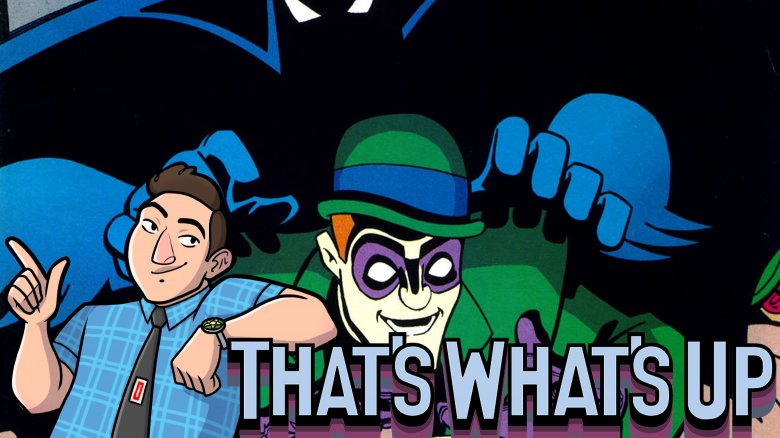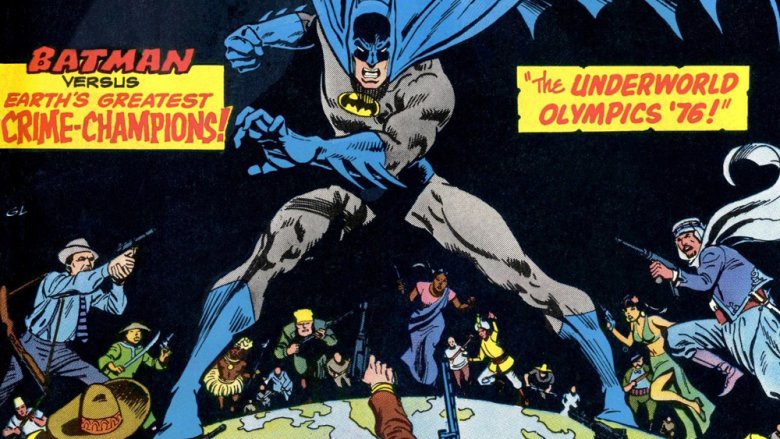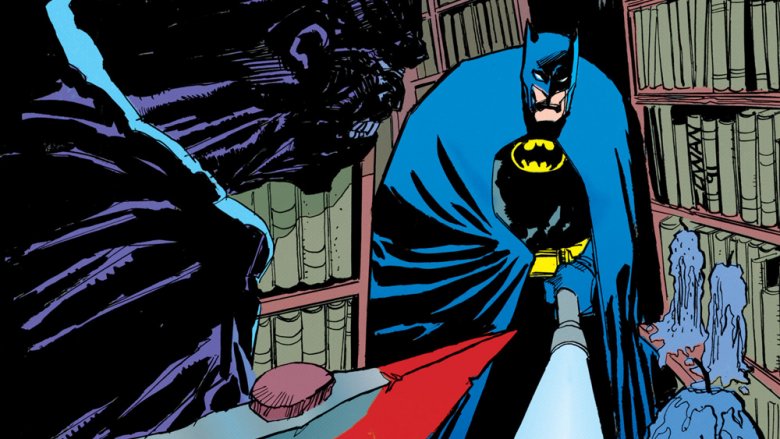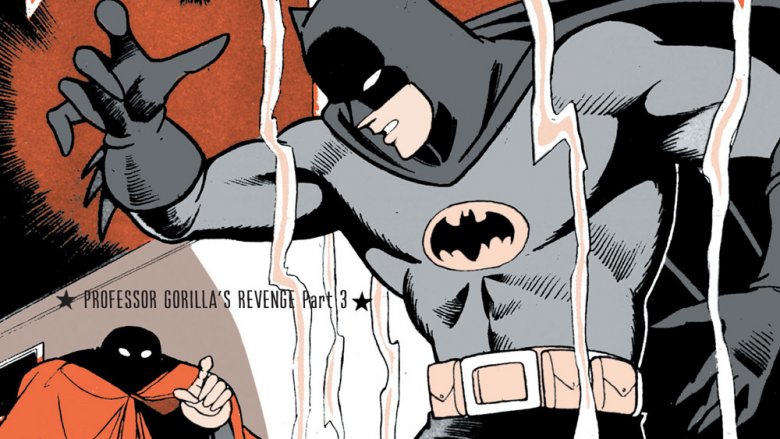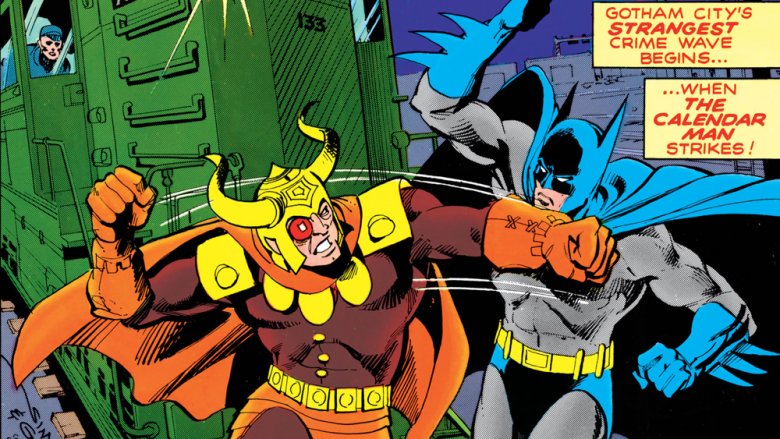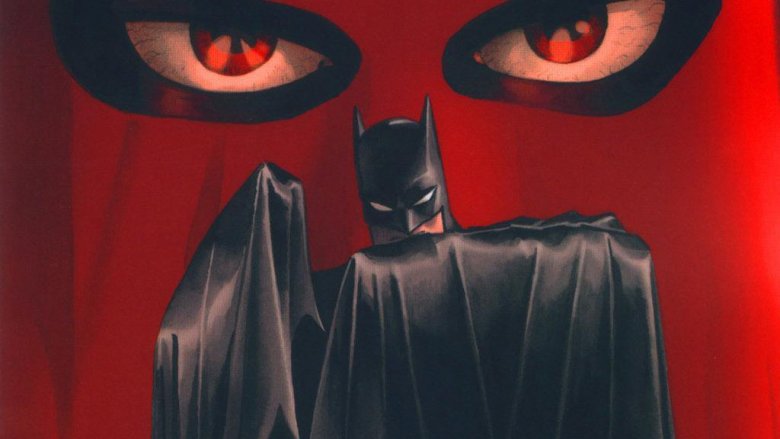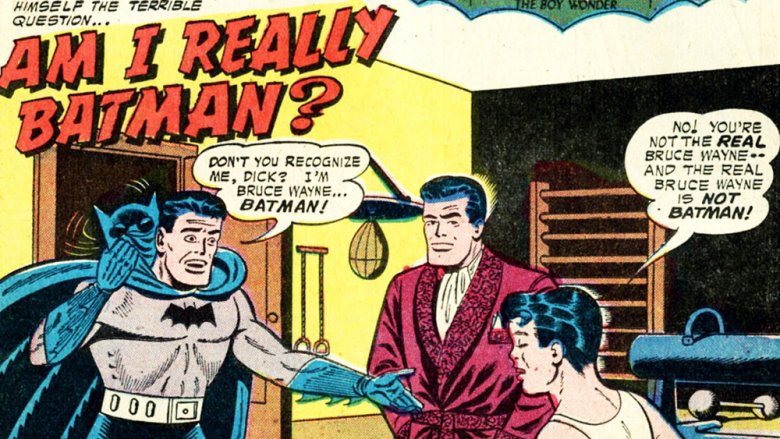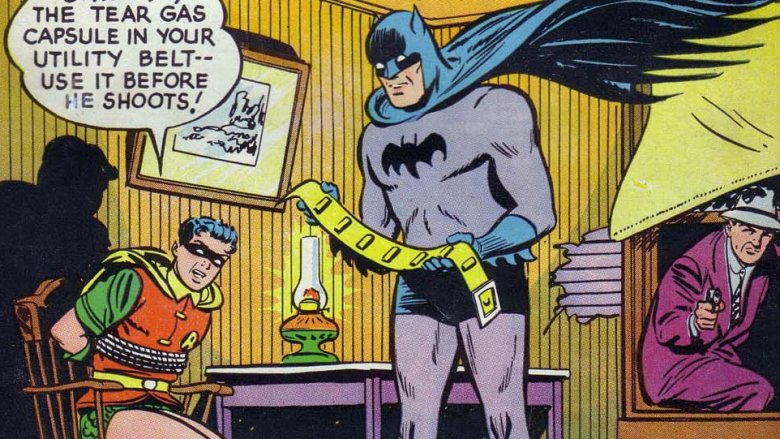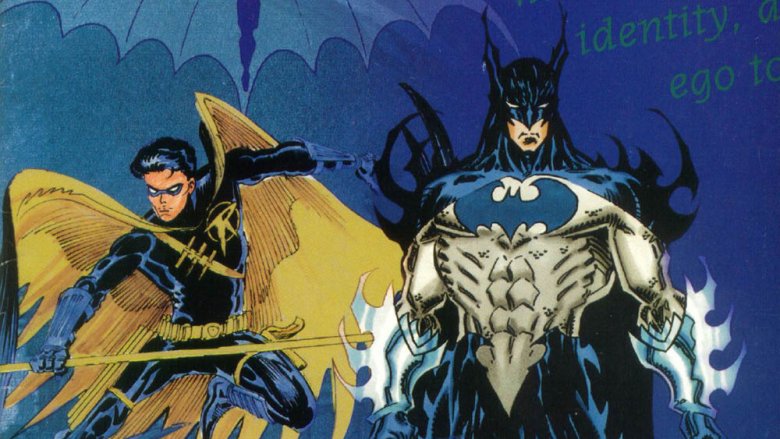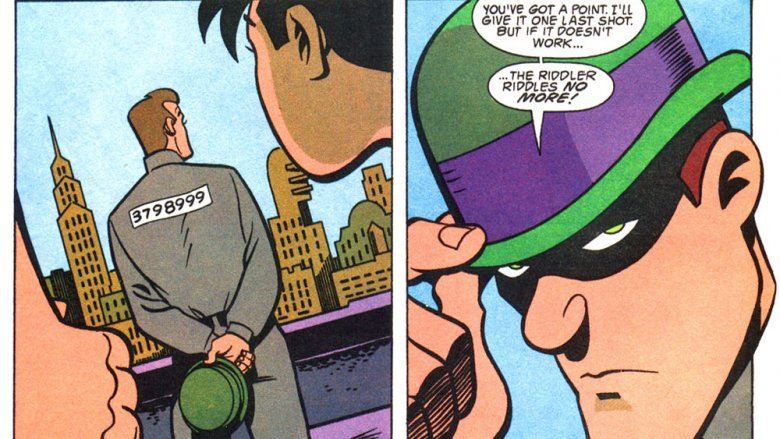That's What's Up: The Best Batman Stories Most Fans Haven't Read
Each week, comic book writer Chris Sims answers the burning questions you have about the world of comics and pop culture: what's up with that? If you'd like to ask Chris a question, please send it to @theisb on Twitter with the hashtag #WhatsUpChris, or email it to staff@looper.com with the subject line "That's What's Up."
Q: I've read the major Batman stories and a few of the more obscure ones, but I really want to dive into the Dark Knight's history. What are the deepest of the deep cuts that I should look out for? — via email
You know, the best thing about Batman is that he's spent 80 years as one of the most popular fictional characters in the world. Thanks to that, he's appeared in so many comic books that you could spend the next year doing nothing but reading them and barely make a dent in the literal thousands of issues of Batman, Detective Comics, Legends of the Dark Knight, Batman and Robin and the countless other titles he's appeared in. It could be a full-time job, and that's if you didn't take a break to check out the TV shows, movies, radio dramas, novels, and anything else that had the pointy-eared crimefighter on the cover.
I'll admit that they're not all the best — and it's not rare to find one that's just flat-out bad — but purely by the law of averages, I'm never going to run out of great Batman stories to talk about. So once you've read through a few of my underappreciated favorites, here are a few obscure but awesome Batman stories to dig up!
Underworld Olympics '76 (Batman #272 - 275)
The cover to 1976's Batman #272, which features a Jose-Luis Garcia-Lopez drawing of a colossal Batman standing astride the planet taking on "Earth's Greatest Crime-Champions," might actually be my single favorite Batman cover of all time, and while I'll admit that the story that runs through the next four issues doesn't quite live up to it, I'm not sure any story could.
Capitalizing on the Olympic fever that sweeps the world every four years, Garcia-Lopez and David V. Reed — a prolific but relatively obscure Batman writer who was always good for a truly bonkers high concept — tell the kind of story that you can only do in a world where the existence of Batman is considered to be a reasonable response to crime. This time, though, the emphasis is on the criminals, who have set their sights on Gotham City for a quadrennial exercise in committing crimes purely for the sake of crime. In a lot of ways, they're the protagonists, and Batman's the obstacle they have to get past.
The premise is so weird that it's almost like a fable: to settle a dispute over which continent has the most effective crooks, delegates from around the (under)world come up with seemingly impossible heists and murders chosen at random, and then score each other on how well they complete their assigned crimes. Involving Batman, for instance, means a mandatory 15-point deduction on your final score. Over the course of four issues, it plays out as Batman fighting a version of "crime" that has no real point beyond just purely being crime, trying to figure out why he's dealing with people who seem to have no real interest in actually profiting from what they're doing. If you like your Batman a little weird (which I do), this is absolutely one to check out.
Library of Souls (Detective Comics #643)
If you've read a Peter Milligan Batman story, then chances are that it was "Dark Knight, Dark City," and for good reason. It's a creepy masterpiece of Batman as a horror movie, full of weird moments like the Riddler being possessed by a demon that Thomas Jefferson summoned to Gotham in the 18th century, and Batman being tricked into performing a weird Satanic ritual without even realizing it. Plus, it's got those covers by Hellboy creator Mike Mignola, so it's easy to see why it's one of the most well-regarded Batman stories of the '90s.
The thing is, though, Milligan actually did a handful of other offbeat Batman stories, and for me, "Library of Souls" is the standout. The thing that really makes it work is that it's built like an old-school Silver Age comic, with an evil librarian dressing his victims up in leather jackets with the Dewey Decimal System numbers that correspond to their professions stitched onto the shoulders. For all its superhero trappings, though, Miligan and veteran Batman artist Jim Aparo play it like a horror movie, with the librarian as a mysterious serial killer, "filing away" corpses by scattering them across the city. It's a great example of how to do a goofy idea with a good amount of creepy darkness and still make it compelling.
Professor Gorilla's Revenge (Batman: The Jiro Kuwata Bat-Manga #12 - 14)
In the 1960s, when the Adam West Batman show pushed the Caped Crusader to new heights of worldwide fame, a Japanese magazine called Shonen Ace started publishing Batman stories by writer/artist Jiro Kuwata. Until 2008, none of these stories had ever been published in America, and in 2014, DC Published the entirety of Kuwata's work in English for the first time. The whole thing feels like a peek into an alternate universe where Go Nagai was in charge of Batman: The Animated Series, and that's something I want to see.
A lot of the stories Kuwata did for Shonen Ace were adaptations of American Batman comics that he expanded and redrew in a classic '60s manga style. The one that got the most attention was Kuwata's take on Lord Death Man, a spooky con artist who appeared to resurrect himself from the dead, but all of those comics are pretty fantastic. I'm particularly fond of the one where Batman fights a pro wrestler named the Hangman, which expands on the American version by having someone say the delightful phrase "I doubt that even Batman could beat a pro wrestler in his own element." Gotta put him over strong, brother!
If I had to pick a favorite, though, it would be "Professor Gorilla's Revenge," in which a gorilla is subjected to experiments that enhance his intelligence, and then decides to become a costumed supervillain in order to get revenge on the scientists that made him. It's a fun little story that's the exact amount of weird, but two things put it over the top. First, it's always amazing to see Batman fistfighting an ape. Second, it contains what might be the single greatest piece of Robin dialogue ever written: "I'll admit: if I were a gorilla and got super powers, I'd probably want to exact revenge on humans too." Truth, Robin. Truth.
A Caper a Day Keeps the Batman Away! (Batman #312)
While we're on the subject of slightly goofy villains, I've always had a soft spot for the Calendar Man. In recent years, he's been the subject of more than one attempt to make him scary and threatening, but I really think he works better when he's just weird. Even in today's Gotham, not every villain has to be a blood-drinking mass murderer. There's nothing wrong with a ruthless, terrifying killer in your Batman comics, but some of them can just be, you know, people who are really into calendars and committing crimes.
Anyway, speech over. This issue is the Calendar Man at his weirdest, with Len Wein and Walt Simonson giving him the gimmick of not just committing a different crime every day of the week, but wearing a different costume, too. There are two absolute highlights, and the first comes in the pages where Simonson — who would do the definitive run on Thor a few years later — dresses him up as Odin for Wednesday, complete with a laser-beam eye and an eight-wheeled motorcycle. The second is at the end, when Batman confronts the Calendar Man at the train station and, despite being in a regular suit and tie, he's in a full-on supervillain costume two pages later, complete with a giant cape made of calendar pages. It's great.
It does, however, have a pretty glaring flaw. On Thursday, the Calendar Man recreates Thor by dressing up as the concept of lightning rather than the actual Norse god. Fortunately, we had five years worth of Thor comics to see Simonson draw the God of Thunder, but it still would've been nice to see him taking a shot across the bow at Marvel in this one.
Batman and the Monster Men/Batman and the Mad Monk
Matt Wagner hasn't written a ton of Batman stories — all told, I'm pretty sure his work amounts to fewer than 20 issues over a career that dates back to the '80s — but given how good they are, he's easily in the running for being one of the best Batman writers (and artists, honestly) of all time.
These particular stories are his best, building off an idea so simple that it's amazing it hadn't really been done before: reimagining Batman's earliest adventures from his first year of publication back in 1939 in the modern, noirish style of Batman: Year One. The result was this: two miniseries, published back to back, that update the pulpy Golden Age stories into some of the best Batman adventures ever published.
Wagner lifts all the elements of the original stories, including the vampiric villain, the Mad Monk, and Hugo Strange's hulking monster men, along with Julie Madison, Bruce Wayne's original love interest. The storytelling is expanded, full of dramatic set pieces, but so much is happening that it never feels slow or overly decompressed. If you're a fan of Year One and want to read stories that feel like a natural transition into more superheroic action — you know, the stuff with vampire cults tearing through Gotham City socialites — these make for the perfect 12-issue companion piece.
Am I Really Batman? (Batman #112)
There are a lot of readers under the mistaken impression that Batman only really got good in the '70s, when darker stories and themes were introduced to pave the way for books like The Dark Knight Returns, but that's not really true. There are plenty of sillier stories from the '50s and '60s — and most of the time, that silliness definitely doesn't prevent them from being pretty solid adventure stories — but darker themes didn't just spring into existence in 1986. As much as they might exist in a brighter version of Gotham, there were a handful of comics that dealt with some pretty weird tweaks to Batman's psychology.
The best (and weirdest) of them is easily 1963's "Robin Dies at Dawn," but if you're looking for something to prove that wasn't the only good Batman story, 1957's "Am I Really Batman?" is the one to go with. The idea this time is that Bruce Wayne wakes up in padded cell, where he's told that he's an imposter dropped off by the real Batman. The rest of the story is devoted to "our" Batman trying desperately to prove his identity even when he's confronted with the "real" Bruce Wayne and Dick Grayson — with the reader being unsure about it for most of the story, too. Even 60 years after it was published, there's a desperation to the way Bill Finger and Sheldon Moldoff do this story that lays the groundwork for similar stories that would come decades after.
Needless to say, actual copies of Batman #112 are pretty difficult to come by, but fortunately this one was reprinted in 1963 in Batman Annual #4, which has in turn been reprinted fairly recently. It might take a bit of work to track it down, but if you're curious to read a great story from Batman's often overlooked Silver Age adventures, this is it.
How To Be The Batman (Detective Comics #190)
The flipside to "Am I Really Batman," a story where Batman has to prove who he is to everyone else, this one's a story where Robin has to convince Bruce Wayne that he is, in fact, Batman. It starts with the Caped Crusader getting dosed by a criminal psychiatrist with an amnesia drug that makes him forget not just that he is Batman, but the very existence of Batman.
It's a great introductory story to the concept, as it involves Robin literally explaining everything about Batman to an extremely confused Bruce who has no idea why he's dressed up in this weird costume — which is probably why it was the first story in the very first Batman Annual, making it easy to find in reprints. Beyond that, though, it's just really fun to see Robin trying to explain Batman, as a concept, to Batman. The best part? Batman is shrugging his way through the entire story, and reacting to all the familiar elements like someone probably would if they had never heard of Batman. He refers to the Batmobile as "a weird car," and when Robin takes him back to the Batcave and shows him the trophies, his reaction is just "they're weird."
Yes, Batman. A dinosaur and a giant penny are very weird things to have in one's basement. Perhaps you really are... the world's greatest detective.
Batman: Knight Gallery
Okay: this is not what you would call a "good" comic in the traditional sense, so if that's what you want, skip down a little because I promise you the next one is one of the legitimate best Batman comics I've ever read. If, however, you want one of the most fun experiences you can have while reading a Batman comic, dig through the quarter bin and pull out this dude right here.
The premise, which is as buck wild as any Batman story from the Silver Age, is that we're looking at "the design journal of Bruce Wayne," full of potential costumes that he sketched out before settling on the familiar one he actually wears in the comics. In reality, it was a fun little experiment where a bunch of artists redesigned the Dark Knight's costume in 1995, with "Bruce's" commentary on each design provided by longtime Batman writer Doug Moench.
As you might guess from the publication date, the designs are truly bonkers, full of pouches and sharp edges — Vincent Giaranno's art in particular, which made it to the cover, looks less like a bat and more like a buzzsaw blade wished really hard and became a real boy. What really makes it great, though, is Moench's commentary, which was clearly added in once the designs were done, and is full of "Bruce" making notes on his own designs about how he couldn't walk through a door while wearing most of these, and, at one point, just saying "Cape impractical." It's a hoot.
The Last Riddler Story (Batman Adventures #10)
Finally, we have "The Last Riddler Story." Plenty of fans regard Batman: The Animated Series as one of the high points of the entire franchise, but what most of them don't know is that the tie-in comic that ran alongside it in the early '90s was just as good as the show. It's full of these perfect little Batman stories, and while #3 contains one of my all-time favorite Joker stories, Kelly Puckett and Mike Parobeck's work in #10 is about as good as a Batman comic can be.
As the title implies, the story starts with the Riddler ready to give up on crime as he's released from his latest prison sentence. He's tired of matching wits with Batman and coming out as the loser each time, so he gives himself an ultimatum: one last crime, with one last riddle, and if Batman figures it out and stops him this time, he's done for good.
It's obvious that there were Riddler stories in the animated continuity that came out after this, but it's also obvious that Batman's the guy with his name on the cover, and doesn't usually fail to stop his arch-enemies from committing their crimes. That's where the fun comes in, with a trio of brand-new villains getting into the mix, and Batman once again serving more as the antagonist for the Riddler than the other way around. It's a beautiful little piece of comics, and so tightly plotted and paced that they honestly ought to teach it in schools. The Riddler's an incredibly underrated villain, and while there are plenty of good stories out there to prove it, this might be the single best one for getting to the core of a character. At the end of the day, he's a guy who wants to prove that he's smarter than Batman, even if it's just this once.
Each week, comic book writer Chris Sims answers the burning questions you have about the world of comics and pop culture: what's up with that? If you'd like to ask Chris a question, please send it to @theisb on Twitter with the hashtag #WhatsUpChris, or email it to staff@looper.com with the subject line "That's What's Up."
